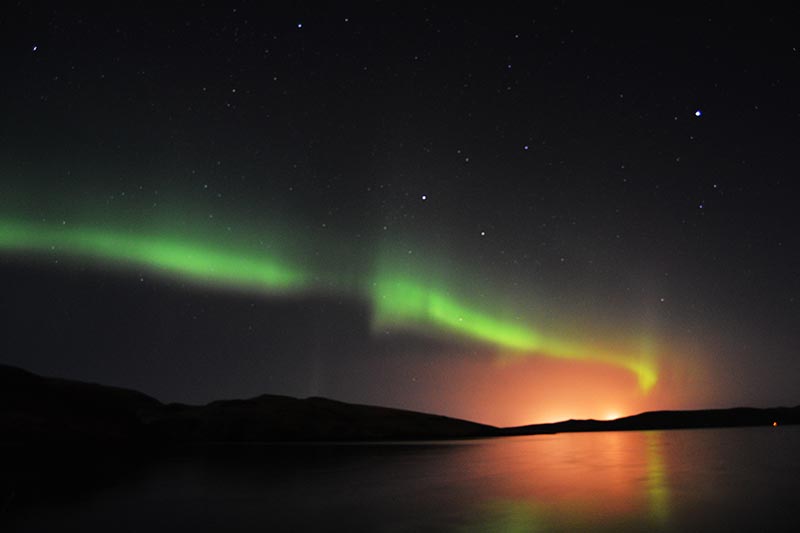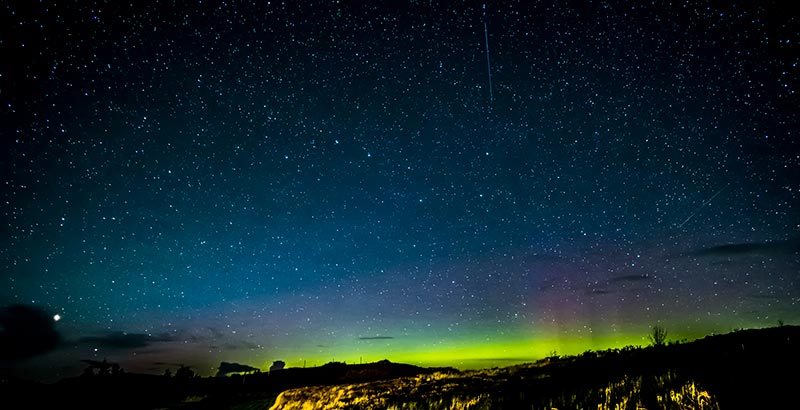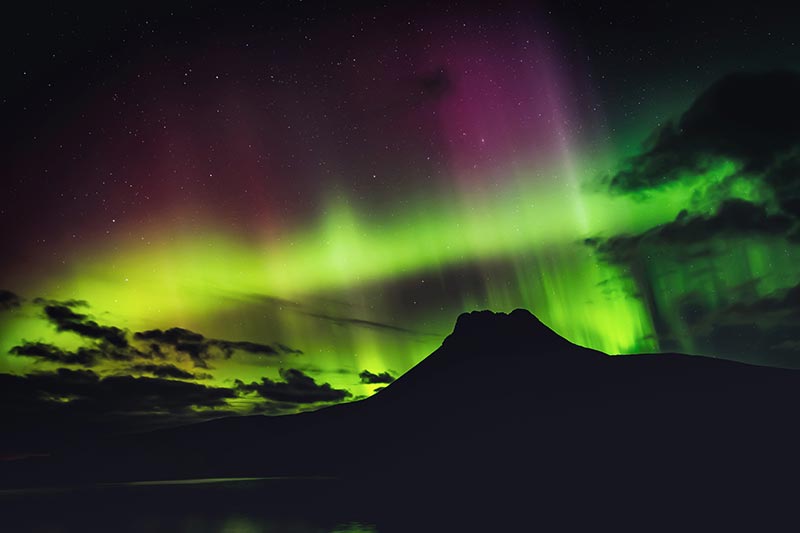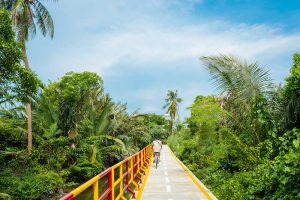The Aurora Borealis, the dancing, multi-coloured lights that can sometimes be seen high in the northern hemisphere, have been a source of awe, fear and great joy for centuries.
To help you choose where to go on your trip to find this natural wonder, we’ve put together a list of the best places to see Northern Lights in Scotland.
BEST TIME OF YEAR TO SEE NORTHERN LIGHTS IN SCOTLAND
The colourful waves of light that entrance human eyes are solar storms of electrically charged atoms and molecules that become trapped in the earth’s magnetic field.
Long nights of clear skies and icy temperatures are the best times to see the Northern Lights in Scotland, so head north in autumn and winter when the weather forecast is hopeful.
There is never a guarantee of seeing magical skies, but to improve your chances, stay out sky-gazing until the early hours and set up camp as far away from light pollution as possible.
BEST PLACES TO SEE NORTHERN LIGHTS IN SCOTLAND
Travel as close to the North Pole as you can to improve your odds of experiencing the elusive Northern Lights. In the U.K, that means planning a trip to Northern Scotland, staying away from the lights of human habitation, and choosing a location where the cloud cover is low, and the solar activity is high.
The north of Scotland is a beautiful place for a holiday. The scenery is varied and ruggedly beautiful. There are oodles of fascinating, historical locations, and the food and drink, locally sourced and lovingly cooked, is delicious.
Here are our favourite places to catch the Aurora Borealis by night and explore during the day.
Inner Hebrides
The Inner Hebrides are a collection of large islands that welcome thousands of visitors every year. In the autumn and winter months, when it is much quieter, hunters of the northern lights flock to them.
The northern tip of the Isle of Skye is the hotspot for this busy holiday isle. Park up in one of the villages dotted around the Quiraing area and trek a couple of miles to the coastline or book a clifftop cottage for a warmer, less strenuous option.
The tiny Isle of Coll is a designated Dark-Sky community whose population remains committed to maintaining this prestigious status. Low light levels ensure velvety blackness and promise the jaw-dropping sight of the Milky Way, rare shimmering night clouds, and an aurora with colours that will fill the entire sky in the right conditions.
Coll is also one of the few parts of western Scotland with no mountains to attract vista interrupting clouds, so clear skies are more likely here than many places.
The Isle of Mull is one of the largest islands in the Inner Hebrides and is a fab place for a fun family holiday. The dark skies and location in the north of Scotland also make it a great place to seek out the aurora.
The quirky, brightly coloured town of Tobermory is a shopper’s paradise, and the coastline has lots of picture-perfect beaches and opportunities to discover the local wildlife and seabirds.
Islay, a historic centre of whiskey distillation, is one of the most populated islands in the Inner Hebrides, and it is the most southern. However, if you head to the quieter, more secluded spots, it is still possible to catch sight of the northern lights.
Shetlands
The Shetland Islands, an archipelago of approximately 100 separate islands between Scotland and Norway, are as far north as you can get in the UK and offer the best chance of seeing the aurora.
Shetland is the main island where you’ll discover jaw-dropping coastline, pretty beaches and restaurants serving some of the best seafood you’ve ever tasted.
If you’re determined to see the Mirrie Dancers, the local name for the shimmering lights, book a stay on one of the smaller, north isles, Fetlar, an island known as ‘the garden of Shetland.’

Outer Hebrides
The Outer Hebrides, a north-western scatter of tiny islands in the wild Atlantic Ocean, are ideally placed for a high chance of seeing the dance of the aurora. They are far to the north and, as there are so few people living here, the night sky is intensely dark.
Head to the Callanish Standing stones on Lewis for an extra-special night of memories that will last forever. This mystical collection of ancient, Neolithic monuments is one of the most amazing places to watch the northern lights in the world.
The main islands of Harris and Lewis are secluded but still hospitable and are a fantastic base from which to journey around the rest of the archipelago. The white sand beaches are gorgeous for windswept picnics, and bodyboarding and pretty towns like Stornoway offer cosy and welcoming pubs for a pint in front of a real fire.
RELATED: BEST WINTER DESTINATIONS IN SCOTLAND
Isle of Skye
Skye is a unique island with scenery that changes from rolling green glens, shining loch, dramatic mountain ranges and peculiar rock formations. Here, you can climb challenging peaks, visit the whiskey distilleries and explore the fairy glens of the Quiraing.
Choose your spot for hunting the Northern Light carefully though, the enormous Cuillin mountains block much of the sky, and there are points of intense light pollution such as Portree.
We recommend the bothy at Rubha Hunish, the northern tip of Skye, as a great spot. As you cosy up waiting for the sun to go down over the sea, it’s fun to spot dolphins and orca whales. Alternatively, the cliffs above the fishing village of Uig are a good spot if you’d rather be a little closer to civilization.

Aberdeenshire & Moray Coast
Set the North-East of the country, Aberdeenshire and the Moray Coast don’t get as much rain as the rest of Scotland, and the Moray Firth has the most days of sun. Those happy statistics mean that a trip here is a good bet in terms of the good weather and clear skies needed to see the Northern Lights!
It’s also a great part of the country to enjoy during the day. Speyside malt whiskey is skilfully created here, and there are plenty of distillery tours to while away an afternoon.
Aberdeenshire is also famed for being ‘Castle Country,’ and history lovers will adore Dunnottar Castle in particular; it is a medieval fortress perched on a rocky headland a three-mile walk from Stonehaven.
<<DOWNLOAD WESOLO TRAVEL APP to plan trips with like-minded travellers>>
Cairngorms National Park
The Cairngorms are a vast range of mountains in the northeast of Scotland. They have a reputation for wildness and are tricky to navigate for the inexperienced, so be careful not to push your limits here.
Brutally beautiful, the Cairngorms National Park, the largest in the country, is about as far away from light pollution as you can get in the UK and are therefore an awe-inspiring place to seek out the northern lights.
Choose somewhere where you can see as much of the sky as possible. Avoid tall trees and a skyline full of the steep mountains of the area. We think the aurora borealis is gorgeous when viewed above a body of light-reflecting water, so Milton Loch or the banks of the River Spey would be a great spot to wait and hope.
Galloway Forest Park
Galloway Forest Park is a fantastic location at which to spot the colourful phenomenon. It is a Gold Tier Dark Sky Park, which means the night sky above the 300 square miles of forest and woodland is exceptionally dark.
The stargazing and planet spotting opportunities in the park are a rarity, with a super bright vision of the Milky Way decorating the sky, and on the right day, the views of the Northern Lights are breathtaking.
During the day, the park is a great place to enjoy a walk, especially when the autumnal colours are in full bloom. There is plentiful wildlife to spot and lochs to stroll around.
North-West Coast, Scottish Highlands
The northwest coast of Scotland and the Highlands beyond are an unspoiled and dramatic contrast of high mountains, sweeping glens and towering cliffs.
Epic skies, limited artificial light sources, and their northern aspect mean that travellers hoping to see the aurora might get lucky. There are lots of beautiful places to stay in this part of Scotland too.
Ullapool, an idyllic old fishing village with iron age relics on the outskirt, is beloved of tourists who want to travel somewhere remote but with good transport connections.
Applecross is an isolated peninsula between the mainland and the Isle of Skye that benefits from both mountain and sea views. It and the surrounding area of Wester Ross are perfect for getting away from the hustle and bustle of a busy life.
Lochinver is another gem of this area. It’s a pretty village with a fishing heritage and jaw-dropping views of Suilven, a unique, remote mountain. It is also the place to eat the legendary pies people travel from miles around for and the perfect fuel for a night hike above the bay to watch for a tell-tale glow on the horizon.












